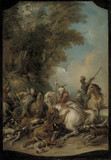Born into a family of painters, Jean-François de Troy was the son of the portraitist François de Troy, from whom he had his first lessons in painting. He later attended the Académie Royale de Peinture et de Sculpture. Although he failed to win the Prix de Rome, probably in 1699 he left for Rome, where he was accepted as a pensionnaire at the Académie Française. He later traveled to Florence, where he found a wealthy patron, and then to Pisa. He returned to Paris, and on the same day in 1708 was both agréé (accepted) and reçu (received) as a history painter by the Académie Royale. He exhibited his reception piece, Niobe and Her Children, at the Salon in the same year. De Troy became professor of the Académie Royale in 1710, and by 1725 was acknowledged as one of the leading painters in France. From 1738 until his death, he served as director of the Académie Française, Rome, while continuing to exhibit regularly at the Salons in Paris. A prolific artist well known for his large mythological and religious scenes, including designs for tapestries, de Troy also painted portraits, landscapes, and genre scenes. He received important commissions for paintings of scenes from contemporary history as well as decorative genre paintings for the palace of Versailles. Among the latter were paintings for the petits appartements, including The Lion Hunt, for which LACMA has the sketch, and The Oyster Luncheon (Chantilly, Musée Condé), which depicts Louis XV and his guests enjoying a meal following a hunt.
Jean-François De Troy
2 records
Include records without images
About this artist

